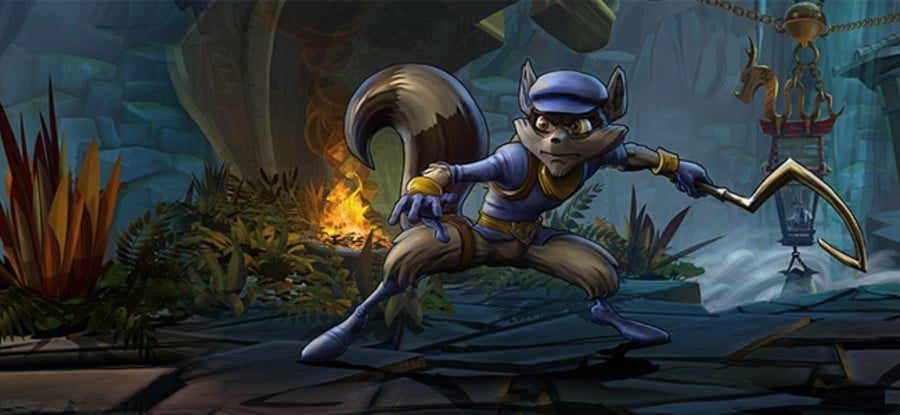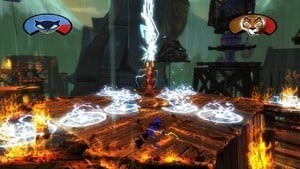
There’s more variety crammed into the opening chapter of Sly Cooper: Thieves in Time than most games manage across an entire campaign. Within the first three hours of the PlayStation 3 sequel, you’ll have performed two heists, spent an afternoon fishing, and even completed a rhythm action mini-game in which an anthropomorphic hippo masquerades as a geisha in front of an audience of leering feudal pigs. This is business as usual for PlayStation’s most endearing platforming trio, and, based on the short snippet we’ve sampled, it’s absolutely brilliant.

The plot picks up shortly after the conclusion of Sly 3: Honor Among Thieves, with the titular tea leaf hooked up with feisty law enforcer Carmelita Fox after feigning amnesia. Elsewhere, brainbox Bentley is busy constructing a time machine with soul-mate Penelope, while the dim-witted Murray is attempting to carve out a career as a destruction derby driver. However, the group’s individual serenity is shattered when the Thievius Raccoonus – the MacGuffin master thief guide book from previous titles – begins to mysteriously lose its contents, bringing the gang back together for another adventure.
The original Sly Cooper trilogy was always at its best during heists, and, as such, it’s not especially surprising to see newcomer Sanzaru Games utilise a multi-tiered mission to kick-start Thieves in Time. Transported to the franchise’s trademark Parisian skyline, the long overdue sequel’s opening objective acts as more of a refresher course than anything else. Despite there being a seven year gap since the series’ last outing, the developer's resisted the temptation to fiddle with the franchise’s formula. Sly is still able to attach to glittery surfaces with a stab of the Circle button, making the platforming feel both more acrobatic and accessible than alternative brands.
Hopping across rooftops – dodging customary circular spotlights along the way – gives the developer the opportunity to flex its visual prowess. In truth, Thieves in Time doesn’t look like a huge upgrade over 2010’s outstanding Sly Cooper Collection at first – but the improvements slowly manifest themselves in minor details. Bugs scatter across the ground, neon lights animate in the background, and the whole image has a busyness to it that wasn’t possible on the PlayStation 2. Furthermore, the game maintains a rock solid frame-rate, giving each character’s playful animation a smooth feel.

As with other entries in the series, the opening mission flits between all three protagonists, with Bentley navigating underground sewers, while Murray picks a fight with a round of armed guards at ground level. The stage culminates with the gang infiltrating a museum and nabbing an old samurai sword, which allows the trio to travel back in time to feudal Japan where they’re able to pick the brains of one of the Thievius Raccoonus’ original authors, Rioichi Cooper.
With the introduction out of the way, Thieves in Time is able to settle into the series’ standard set-up. Japan provides a small sandbox for the gang to explore, packed with treasures, bottles, and other trinkets to collect. Missions are spread across each of the protagonists – and later Rioichi – though you’re free to tackle them at your own pace. The environment itself is packed with cheeky landmarks, such as a giant sushi restaurant and an enormous geisha house decorated with giant neon signposts. Did you know that they had animated displays in the 17th Century?
Thankfully, historical accuracy is a minor issue when you’re pick-pocketing coins from a flamingo’s open wallet. More meaningful is the strength of the art direction, which is brightly coloured and highlighted by thick black borders. The draw distance is great, and even when you’re scaling tall buildings the game maintains that all important silky smooth frame-rate. Scouring the environment for rogue collectibles remains as addictive as ever, consuming your attention between (and sometimes during) missions.

Objectives in the first chapter start out familiar, but gradually grow in scope. Taking the time to photograph key landmarks will not come as a surprise to long-term fans of the franchise, but the game gradually introduces new ideas as you progress. One mission sees you spend a few moments fishing, using the SIXAXIS controller to hook aquatic creatures from a first-person perspective. It’s gimmicky and, in all honesty, a bit silly, but it lasts for about 30 seconds and then you move onto something new. Another stage sees you controlling a remote-controlled car that’s able to transform into a chicken in order to disguise itself from sleepy guards. And, of course, there’s the aforementioned rhythm game which finds you matching button prompts to control one of the most comical sequences in the sequel so far.
In between missions, you’ll of course find yourself double-jumping, thumping, and assassinating foes. One of the big new additions to the sequel is Sly’s ability to don costumes, which augments the character with new abilities. The feudal armour introduced in this chapter allows the protagonist to slip by guards unnoticed, and also protect him from fire. One particularly lengthy mission sees you needing to switch between the disguise and your normal getup in order to avoid flamethrowers and deadly axes in quick succession. Hitting the L2 button prompts a quick change, adding some dexterity to proceedings outside of the standard platforming.
Throughout the first chapter, the game also introduces Sly’s aforementioned ancestor Rioichi Cooper. While the ninja master doesn’t play particularly differently to the titular all-star, he does possess a few new tricks. By tugging the R2 trigger you can initiate a focus mode which allows you to jump longer distances than the main character. This is all factored into the level design, with Rioichi’s missions including some pretty massive jumps.

The hideout that serves as the hub between missions has also been granted a lick of paint since previous entries. You can still purchase upgrades from the Thief Net with your coins, but you can also engage in some mini-games. We got to sample a simple round of table-tennis, but there also appear to be arcade cabinets to unlock.
Speaking of which, Bentley’s hacking games have been massively improved. The isometric shooter from previous titles has been re-purposed here, but it’s been joined by a Geometry Wars-esque bullet-hell side-scroller – complete with rapid upgrades – and a two-dimensional twist on Marble Madness that once again takes advantage of the SIXAXIS controller. If you’d forgotten all about the DualShock 3’s accelerometer, then Thieves in Time is keen to give you a quick reminder.
The chapter culminates with a heist that once again reinforces the gang nature of the gameplay. Because of the scale of the engine, you really get a much bigger sense of the mission, as you hop between perspectives and impact the overall objective. A final boss fight against a cigar chuffing tiger really enforces the visual improvements, as Sly is prompted to make a dash across a collapsing fortress in the rain. It looks fantastic.
With the promise of at least four more worlds to explore, we’re eager to see where Thieves in Time travels next. It may not stray too far away from the blueprints that original developer Sucker Punch penned, but Sanzaru Games has already proven itself as a worthy substitute for the supercharged first-party studio. We’ll get to steal a more prolonged session with the long overdue sequel when the full title releases on 5th February in North America.





Comments 7
Starts after the 3rd one?! I need to play the 2nd & 3rd before I go for this one!!
@ZeD They're all awesome! Play them over Christmas, you won't regret it!
My games list is HUGE atm! Will look for the game for cheap!
Edit: Any one have any spare copies knocking around? lol
You can find The Sly Collection cheap on Amazon it's worth every penny.
I picked up the collection on Black Friday for $10. I've finished the first but never got into the other two yet. Looks like I'm running out of time.
I cannot wait to see more regarding the Vita support for this game
I'm half way through the sly collection, there great just "fun" games.
Did you guys get to try out the vita version?
@Dambuster I didn't get to play the same section on Vita, but I have played an earlier build of the handheld version and it's great. Works just as you'd expect it to.
Show Comments
Leave A Comment
Hold on there, you need to login to post a comment...